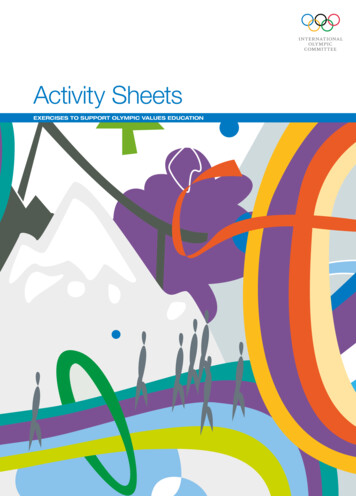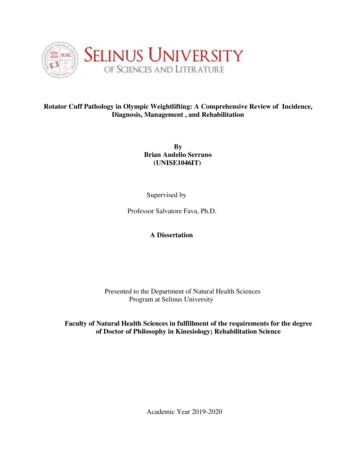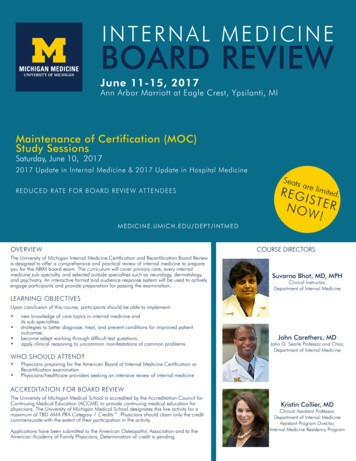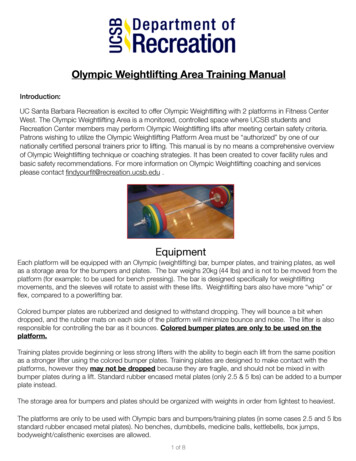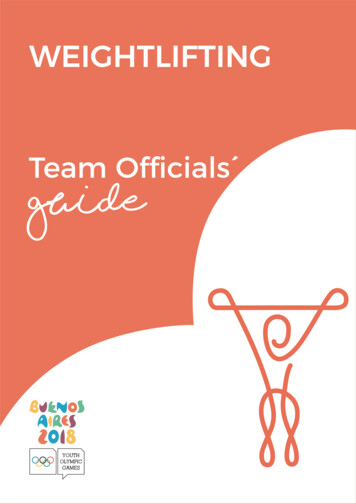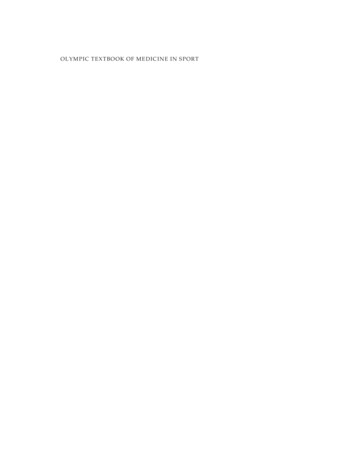
Transcription
9781405156370 1 A01.qxd 6/12/08 11:09 AM Page iOLYMPIC TEXTBOOK OF MEDICINE IN SPORT
9781405156370 1 A01.qxd 6/12/08 11:09 AM Page ii
9781405156370 1 A01.qxd 6/12/08 11:09 AM Page iiiO LY M P I C T E X T B O O K O FM E D I C I N E I N S P O RTVOL UME XIV OF THE ENCYCLOPAEDIA OF SPORTS MEDICINEAN IOC MEDICAL COMMISSION PUBLICATIONEDITED BYPROFESSOR MARTIN P. SCHWELLNUS, MBBCh, MSc, MDA John Wiley & Sons, Ltd., Publication
9781405156370 1 A01.qxd 6/12/08 11:09 AM Page ivThis edition first published 2008, 2008 International Olympic CommitteePublished by Blackwell Publishing LtdBlackwell Publishing was acquired by John Wiley & Sons in February 2007. Blackwell’s publishing programhas been merged with Wiley’s global Scientific, Technical and Medical business to form Wiley-Blackwell.Registered office: John Wiley & Sons Ltd, The Atrium, Southern Gate, Chichester, West Sussex, PO19 8SQ, UKEditorial offices: 9600 Garsington Road, Oxford, OX4 2DQ, UKThe Atrium, Southern Gate, Chichester, West Sussex, PO19 8SQ, UK111 River Street, Hoboken, NJ 07030-5774, USAFor details of our global editorial offices, for customer services and for information about how to apply forpermission to reuse the copyright material in this book please see our website at www.wiley.com/wileyblackwellThe right of the author to be identified as the author of this work has been asserted in accordance with theCopyright, Designs and Patents Act 1988.All rights reserved. No part of this publication may be reproduced, stored in a retrieval system, ortransmitted, in any form or by any means, electronic, mechanical, photocopying, recording or otherwise,except as permitted by the UK Copyright, Designs and Patents Act 1988, without the prior permission of thepublisher.Wiley also publishes its books in a variety of electronic formats. Some content that appears in print may not beavailable in electronic books.Designations used by companies to distinguish their products are often claimed as trademarks. All brandnames and product names used in this book are trade names, service marks, trademarks or registeredtrademarks of their respective owners. The publisher is not associated with any product or vendor mentionedin this book. This publication is designed to provide accurate and authoritative information in regard to thesubject matter covered. It is sold on the understanding that the publisher is not engaged in renderingprofessional services. If professional advice or other expert assistance is required, the services of a competentprofessional should be sought.The contents of this work are intended to further general scientific research, understanding, and discussiononly and are not intended and should not be relied upon as recommending or promoting a specific method,diagnosis, or treatment by physicians for any particular patient. The publisher and the author make norepresentations or warranties with respect to the accuracy or completeness of the contents of this work andspecifically disclaim all warranties, including without limitation any implied warranties of fitness for aparticular purpose. In view of ongoing research, equipment modifications, changes in governmentalregulations, and the constant flow of information relating to the use of medicines, equipment, and devices, thereader is urged to review and evaluate the information provided in the package insert or instructions for eachmedicine, equipment, or device for, among other things, any changes in the instructions or indication of usageand for added warnings and precautions. Readers should consult with a specialist where appropriate. Thefact that an organization or Website is referred to in this work as a citation and/or a potential source of furtherinformation does not mean that the author or the publisher endorses the information the organization orWebsite may provide or recommendations it may make. Further, readers should be aware that InternetWebsites listed in this work may have changed or disappeared between when this work was written andwhen it is read. No warranty may be created or extended by any promotional statements for this work.Neither the publisher nor the author shall be liable for any damages arising herefrom.Library of Congress Cataloging-in-Publication DataThe Olympic textbook of medicine in sport / edited by Martin Schwellnus.p. ; cm. – (Encyclopaedia of sports medicine ; v. 14)“An IOC Medical Commission publication in collaboration with the International Federation of SportsMedicine.”Includes bibliographical references.ISBN 978-1-4051-5637-0 (alk. paper)1. Sports medicine. I. Schwellnus, Martin. II. IOC Medical Commission. III. International Federationof Sports Medicine. IV. Series.[DNLM: 1. Sports Medicine. 2. Athletic Injuries. 3. Athletic Performance. QT 13 E257 1988 v.14]RC1210.O46 2008617.1’027– dc222008005042ISBNs: 978-1-4051-5637-0;978-1-4051-9077-0 (leather bound)A catalogue record for this book is available from the British Library.Set in 9/12 pt Palatino by Graphicraft Limited, Hong KongPrinted and bound in Malaysia by Vivar Printing Sdn Bhd12008
9781405156370 1 A01.qxd 6/12/08 11:09 AM Page vContentsList of Contributors, vii3The Overtraining Syndrome: Diagnosis andManagement, 138romain meeusenPreface, xi4General Principles of Training, 1michael i. lambert, wayne viljoen,andrew bosch, alan j. pearce andmark sayersClinical Exercise Testing and Assessment ofAthletes, 160robert u. newton, paul b. laursenand warren young5Clinical Myology in Sports Medicine, 200wayne e. derman, martin p.schwellnus, dale e. rae, yumnaalbertus-kajee and michael i. lambert6Sports Cardiology, 232christos kasapis and paul d.thompson7Sports Pulmonology, 268joseph cummiskey, kai-håkoncarlsen, keun-youl kim, conlethfeighery, andrew green, fabiopigozzi, walter canonica, vitobrusasco, stefano del giacco,sergio bonini and matteo bonini8Endocrinology, 302jeffrey m. anderson, thomas h.trojian and william j. kraemer9Dermatology, 326brian b. adamsForeword, x12Adaptations to Training, 49Introduction, 49iñigo mujikaModels of fatigue, 49shona halson and iñigo mujikaNeuromuscular adaptations to training, 67nicholas a. ratamess and mikelizquierdoMetabolic adaptations to training, 78john a. hawley and gustavoa. naderEndocrine adaptations to training, 87michael kj Æ r, simon doessing andkatja peltola mj Ø sundCardiorespiratory adaptations to training, 93darren e.r. warburton, a. williamsheel and donald c. mckenzieAdaptations of bone and connective tissueto training, 111pekka kannus, riku nikander, harrisievänen and iñigo mujika10Exercise and Infections, 344martin p. schwellnus, austin jeans,sello motaung and jeroen swartv
9781405156370 1 A01.qxd 6/12/08 11:09 AM Page vivi1112131415contentsGastrointestinal System and Exercise: AClinical Approach to GastrointestinalProblems Encountered in Athletes, 365martin p. schwellnus and johnwrightExercise and the Kidney, 375brian rayner and martin p.schwellnusObstetrics and Gynecology, 390raul artal and susanhoffstetterNeurologic Problems in Sport, 412paul mccroryMedical Care of the Disabled Athlete, 429douglas b. mckeag and chrisklenck16Environmental Sports Medicine, 444timothy d. noakes, tamarahew-butler and ross tucker17Drugs in Sport, 482don h. catlin, gary green andcaroline k. hatton18Emergency Sports Medicine, 504lucy-may holtzhausen and chrishanna19Genetics and Sports Participation, 548kyriacos i. eleftheriou and hughe. montgomery20Sports Nutrition: Practical Guidelines for theSports Physician, 580louise m. burkeIndex, 601
9781405156370 1 A01.qxd 6/12/08 11:09 AM Page viiList of ContributorsBRIAN B. ADAMS MD, MPH, Department ofDermatology, University of Cincinnati, Cincinnati, OH,USA, and Veterans Administration Medical Center,Cincinnati, OH, USAWALTER CANONICAMD, Department ofAllergy and Respiratory Disease Clinic, Department ofInternal Medicine, Genoa University, Genoa, ItalyKAI-HÅKON CARLSEN MD, PhD, UniversityYUMNA ALBERTUS-KAJEEBsc(Med),UCT/MRC Research Unit for Exercise Science andSports Medicine, Department of Human Biology,Faculty of Health Sciences, University of Cape Town,South Africaof Oslo, Norwegian University of Sport and PhysicalEducation, Oslo, NorwayDON H. CATLIN MD, Department of Molecularand Medical Pharmacology, University of California, LosAngeles, Anti-Doping Research, Inc., Los Angeles, CA, USAJEFFREY M. ANDERSON MD, Divisionof Athletics, University of Connecticut, Storrs, CT, USAJOSEPH CUMMISKEY MD, The BlackrockClinic, Blackrock, Dublin, IrelandRAUL ARTALMD, Department of Obstetrics,Gynecology and Women’s Health, St. Louis University,School of Medicine, St. Louis, MO, USAMATTEO BONINIMD, PoliclinicoUniversitario, University of Cagliari, Monserrato,ItalyMD, IRCCS San Raffaelo,WAYNE E. DERMANRome, ItalySERGIO BONINISTEFANO DEL GIACCOMD, IRCCS San Raffaello,Rome, ItalyANDREW BOSCH PhD, UCT/MRC ResearchUnit for Exercise Science and Sports Medicine,Department of Human Biology, University ofCape Town, South AfricaMBChB, PhD,UTC/MRC Research Unit for Exercise Science and SportsMedicine, Department of Human Biology, Faculty of HealthSciences, University of Cape Town, South AfricaSIMON DOESSING MD, Institute of SportsMedicine, Copenhagen University Hospital at Bispebjerg,Copenhagen, DenmarkKYRIACOS I. ELEFTHERIOU MBBS,VITO BRUSASCOMD, Department of InternalMedicine, Genoa University, Genoa, ItalyMRCS(Ed), UCL Centre for Health and HumanPerformance, Royal Free and University College MedicalSchool, London, UKLOUISE M. BURKE PhD, APD, Department ofSports Nutrition, Australian Institute of Sport, Bruce,ACT, Australia, and Deakin University, Melbourne,Victoria 3125, AustraliaCONLETH FEIGHERY MD, Department ofImmunology, St. James’ Hospital and Trinity CollegeDublin, Dublin, Ireland
9781405156370 1 A01.qxd 6/12/08 11:09 AM Page viiiviiilist of contributorsANDREW GREEN PhD, National Centre forMedical Genetics, University College Dublin, IrelandGARY GREENMD, Division of Sports Medicine,University of California, Los Angeles, and Pacific PalisadesMedical Group, Pacific Palisades, CA, USASHONA HALSONPhD, Department of Physiology,Australian Institute of Sport, Belconnen, ACT, AustraliaCHRIS HANNA MBChB, Adidas Sport MedicineCenter, St. Johns, Auckland, New ZealandCAROLINE K. HATTON PhD, Anti-DopingResearch, Inc., Los Angeles, CA, USAJOHN A. HAWLEY PhD, Exercise MetabolismGroup, School of Medical Sciences, RMIT University,Bundoora, Victoria, AustraliaTAMARA HEW-BUTLERPhD, UCT/MRCResearch Unit for Exercise Science and Sports Medicine,Department of Human Biology, Sports Science Institute ofSouth Africa, South AfricaSUSAN HOFFSTETTER PhD, Department ofObstetrics, Gynecology and Women’s Health, St. LouisUniversity, School of Medicine, St. Louis, MO, USALUCY-MAY HOLTZHAUSEN MBBCh, BSc,Auckland Family Medical Center, Remuera, Auckland,New ZealandMIKEL IZQUIERDO PhD, Studies, Researchand Sport Medicine Center, Government of Navarra,Pamplona, SpainAUSTIN JEANSMBBCh, BSc, Centre for Sport andExercise Medicine, Harare, ZimbabweMICHAEL KJÆRMD, PhD, Institute of SportsMedicine, Copenhagen University Hospital at Bispebjerg,Copenhagen, DenmarkCHRIS KLENCK MD, University of Tennessee,Knoxville, TN, USAWILLIAM J. KRAEMER PhD, HumanPerformance Laboratory, Department of Kinesiology,University of Connecticut, Storrs, CT, USAMICHAEL I. LAMBERT PhD, UCT/MRCResearch Unit for Exercise Science and Sports Medicine,Department of Human Biology, Faculty of HealthSciences, University of Cape Town, South AfricaPAUL B. LAURSENPhD, School of Exercise,Biomedical and Health Sciences, Edith Cowan University,Joondalup, Western Australia, AustraliaPAUL MCCRORY MBBS, PhD, Centre for Health,Exercise and Sports Medicine, University of Melbourne,Parkville, Victoria, AustraliaDOUGLAS B. MCKEAG MD, MS, IU Centerfor Sports Medicine, Department of Family Medicine,School of Medicine, Indiana University, Indianapolis,IN, USADONALD C. MCKENZIE MD, PhD, Divisionof Sports Medicine, Faculty of Medicine, University ofBritish Columbia, Vancouver, BC, CanadaROMAIN MEEUSEN PhD, Vrije UniversiteitBrussel, Faculteit LK – Department of Human Physiology& Sports Medicine, Brussels, BelgiumKATJA PELTOLA MJØSUNDMD,Biomedicum – Helsinki, Helsinki University, FinlandHUGH E. MONTGOMERY MBBS, MRCP,PEKKA KANNUSMD, PhD, Accident and TraumaResearch Center, UKK Institute, Tampere, FinlandMD, UCL Centre for Health and Human Performance,Royal Free and University College Medical School,London, UKCHRISTOS KASAPIS MD, Department ofCardiovascular Medicine, University of Michigan, AnnArbor, MI, USAKEUN-YOUL KIMMD, MPH, PhD, MedicalCollege of Seoul National University, Seoul, KoreaSELLO MOTAUNGBSc, MBBCh, Centrefor Exercise Science and Sports Medicine, School ofTherapeutic Sciences, Faculty of Health Sciences,University of the Witwatersrand, Johannesburg,South Africa
9781405156370 1 A01.qxd 6/12/08 11:09 AM Page ixlist of contributorsIÑIGO MUJIKA PhD, Department of Research andDevelopment, Athletic Club Bilbao, SpainGUSTAVO A. NADER PhD, Department ofClinical Neuroscience, Center for Molecular Medicine,Karolinska Institute, Stockholm, SwedenixMARTIN P. SCHWELLNUS MBBCh,MSc, MD, UCT/MRC Research Unit for Exercise Scienceand Sports Medicine, Department of Human Biology,Faculty of Health Sciences, University of Cape Town,South AfricaA. WILLIAM SHEEL PhD, School of HumanROBERT U. NEWTONPhD, School of Exercise,Biomedical and Health Sciences Edith Cowan University,Joondalup, Western Australia, AustraliaKinetics, University of British Columbia, Osborne Centre,Vancouver, BC, CanadaHARRI SIEVÄNEN MD, PhD, Accident andRIKU NIKANDER MD, PhD, Accident and TraumaResearch Center, UKK Institute, Tampere, FinlandTIMOTHY D. NOAKES MBChB, MD, DSc,UCT/MRC Research Unit for Exercise Science and SportsMedicine, Department of Human Biology, Sports ScienceInstitute of South Africa, South AfricaALAN J. PEARCE PhD, Centre for Aging,Rehabilitation, Exercise and Sport (CARES), School ofHuman Movement, Recreation and Performance, VictoriaUniversity, Melbourne, Victoria, AustraliaFABIO PIGOZZIMD, Internal Medicine Unit,Department of Health Services, University of Rome (IUSM),Rome, ItalyTrauma Research Center, UKK Institute, Tampere,FinlandJEROEN SWART MBChB, UCT/MRC ResearchUnit for Exercise Science and Sports Medicine, Departmentof Human Biology, Sports Science Institute of South Africa,South AfricaPAUL D. THOMPSON MD, PreventiveCardiology & The Athletes’ Heart Program, Divisionof Cardiology, Hartford Hospital, Hartford, CT,USATHOMAS H. TROJIAN MD, Division ofAthletics, University of Connecticut, Storrs, CT, USAROSS TUCKER PhD, UCT/MRC Research Unit forDALE E. RAE PhD, UCT/MRC Research Unit forExercise Science and Sports Medicine, Department ofHuman Biology, Faculty of Health Sciences, Universityof Cape Town, South AfricaExercise Science and Sports Medicine, Department ofHuman Biology, Sports Science Institute of South Africa,South AfricaWAYNE VILJOEN PhD, Sport Science InstituteNICHOLAS A. RATAMESS PhD, Departmentof Health and Exercise Science, The College of New Jersey,Ewing, NJ, USABRIAN RAYNER MBChB, MMed, Department ofMedicine, Faculty of Health Sciences, University of CapeTown, South Africaof South Africa, Newlands, Cape Town, South AfricaDARREN E.R. WARBURTONPhD, Schoolof Human Kinetics, University of British Columbia,Vancouver, BC, CanadaJOHN WRIGHT MBChB, PhD, Fairfield Suites,Kingsbury Hospital, Claremont, South AfricaMARK SAYERS PhD, Centre for Healthy Activities,Sport and Exercise (CHASE), Faculty of Science, Health andEducation, University of the Sunshine Coast, MaroochydoreDC, Queensland, AustraliaWARREN YOUNGPhD, School of HumanMovement and Sport Sciences, University of Ballarat,Ballarat, Victoria, Australia
9781405156370 1 A01.qxd 6/12/08 11:09 AM Page xForewordThis Volume represents the XIVth volume of The Encyclopaedia of Sports Medicine series, scientific publications by the IOC Medical Commission which began in 1988 with Volume I, The Olympic Book of SportsMedicine. To produce each volume, the most respected clinicians and scientific investigators have collaborated to produce reference texts that are both comprehensive for the topic and representative of the leadingedge of knowledge.The positive impact of the Encyclopaedia on a central theme, the health and welfare of all persons participating in sport, has exceeded all expectations.Volume XIV, The Olympic Textbook of Medicine in Sport, addresses the clinical issues that were includedin the original Volume I and synthesizes the new research information that has been published during theintervening 20 years. I wish to congratulate Professor Martin Schwellnus and all of the Contributing Authorson the excellent quality of this publication.Dr Jacques RoggePresident of the International Olympic Committee
9781405156370 1 A01.qxd 6/12/08 11:09 AM Page xiPrefaceSports and Exercise Medicine can be defined as thatscope of medical practice which focuses on (i) theprevention, diagnosis, treatment and rehabilitationof injuries that occur during physical activity, (ii) theprevention, diagnosis, and management of medical conditions that occur during or after physicalactivity, and (iii) the promotion and implementation of regular physical activity in the prevention,treatment and rehabilitation of chronic diseases oflifestyle. Over the past two to three decades, therehas been an exponential increase in the number ofpublished research articles, books and other publications that cover these areas of medical practice. Ingeneral, most publications (in particular textbooks)cover the first (injury prevention and treatment)and the third (chronic disease prevention and rehabilitation) areas of Sports and Exercise Medicinevery well. However, the area in Sports and ExerciseMedicine that has not received the same attention inthe published literature is the prevention, diagnosis,and management of medical conditions that occurduring or after physical activity. It is for that reason,that this new volume of The Encyclopaedia of SportsMedicine series has been compiled, specifically toprovide sports medicine practitioners with a systematic approach to this very important aspect of sportsmedicine practice.It is well recognized that the team physician,including the members of the medical team attending to Olympic athletes, commonly encounter medical problems that are non-injury related. It hasbeen reported that about 50% of the 1804 athletesseen at the multipurpose medical facility at the1996 Olympic Games were seen for treatment ofnon-injury related illnesses. A similar pattern hasbeen observed in subsequent Olympic Games, andthis is also a common observation by team physicians who travel with athletes in other sportingdisciplines.In compiling this volume, it was therefore decidedto follow a systemic approach that will provide thesports medicine practitioner with a clinical approachto the prevention, diagnosis and treatment of common and less common medical problems encountered in athletes. This volume contains 20 chapters.The first three introductory chapters deal with thebasic approach to training, monitoring training andthe clinical implications of excessive training. Theremaining 17 chapters systemically deal with all themajor systems in the body, and focus on medicalconditions that athletes may suffer from in eachsystem. Special mention has to be made of threenovel chapters that focus on medical conditions inathletes with disabilities, genetics and exercise andemergency sports medicine. Each chapter editor wasselected on the basis of their expertise, and chaptereditors were also encouraged to solicit contributingauthors for specialized sections within chapters.This approach has led to a volume that has animpressive list of authors – all experts in their field.It has been a privilege for me to work with theseexperts in compiling this volume, and I trust thatyou as the reader will find the volume inspiring,comprehensive and a truly novel resource that willbe consulted regularly in your practice. I also trustthat the use of this volume by sports practitionerswill also ultimately improve the medical service toour athletes.
9781405156370 1 A01.qxd 6/12/08 11:09 AM Page xiixiiprefaceAcknowledgementsI would like to sincerely thank all the chaptereditors and contributing authors for their hardwork, dedication, and willingness to share theirexpertise. In particular, I would like to thank allof the contributors for giving up time amidsttheir very busy schedules. A special thanks hasto go to Professor Howard Knuttgen, Coordinatorof Scientific Publications for the IOC MedicalCommission, for initiating this project, and forhis constant support and encouragement. Alsomany thanks to the editorial and support staffat Blackwell for their support. Finally, thanks tothe IOC Medical Commission and the International Sports Medicine Federation (FIMS) for allowing me to edit this volume in the Encyclopaediaseries.Martin P. Schwellnus, MBBCh, MSc, MD
9781405156370 4 001.qxd 6/12/08 11:09 AM Page 1Chapter 1General Principles of TrainingMICHAEL I. LAMBERT, WAYNE VILJOEN, ANDREW BOSCH,ALAN J. PEARCE AND MARK SAYERSExercise training can be defined as a systematicprocess of preparing for a certain physical goal. Thisgoal used to be synonymous with peak physicalperformance; however, exercise training is alsoused to achieve targets for health-related fitness.As society evolves and becomes more sedentary(Dollman et al. 2005) there is greater emphasis onhabitual physical activity with the aim of reducingobesity, adult onset diabetes, hypertension and therisk of heart disease. Indeed, there are specificguidelines which have been have written for prescribing exercise for these conditions (AmericanCollege of Sports Medicine 1998).An understanding shared by coaches and athletesalike, all over the world, is the general concept thatphysical performance improves with training(Foster et al. 1996). The specific guidelines on how toachieve peak performance are not so clear, becauseof the diverse capabilities, goals and types of sport.For example, a sedentary person may have a goal oftraining to develop sufficient fitness for running5 km without stopping. This can be compared to thegoal of a professional athlete who trains accordingto a program with the aim of reducing his 5-km timeby 3 s. However, irrespective of the goal, there arebasic principles of training which can be applied toplan training programs.Training for peak sporting performance includestraining for physical development (general andsport-specific factors), and technical and tacticalThe Olympic Textbook of Medicine in Sport, 1st edition.Edited by M. Schwellnus. Published 2008 by BlackwellPublishing, ISBN: 978-1-4051-5637-0.training (Bompa 1999). Athletes also have to trainpsychologic aspects and in team sports athleteshave to train for the development of team compatibility to ensure harmony within the team structure.To complete the requirements for achieving peakperformance, athletes need to be healthy and free ofinjuries and have a theoretical knowledge of theirtraining in preparation for their sport so that theycan take some responsibility for their progress(Bompa 1999).Long-term planning for the career of an eliteathlete covers 10–15 years (Smith 2003). However,the age at which competitors reach their peak variesaccording to the sport. For example, in sports suchas gymnastics, figure skating, and swimming competitors reach their peak in their late teens or earlytwenties, in contrast to other sports such as soccer,rugby, and distance running where competitorsreach their peak success in their late twenties orearly thirties (Bompa 1999). In sports such as golfand lawn bowls, in which the technical attributesare the most important factors determining success,the age of elite performers may be 40 or 50 years.Generally, the starting age of athletes in the moretechnical sports, which require the developmentof fine motor coordination skills, is younger thanathletes competing in sports that are less technicalbut depend more on physical ability.This chapter discusses the evolution of trainingprinciples with a contemporary view of the factorsthat need to be considered in devising a trainingprogram. Specifically, it discusses the principles oftraining programs that are designed to improvepeak performance coinciding with competition.1
9781405156370 4 001.qxd 6/12/08 11:09 AM Page 22c ha p ter1This is followed by sections on specific training principles for strength, endurance, and skill acquisition.HistoryExercise training to improve performance can betraced back to early civilizations (Kontor 1988).There is evidence for both strength training andstrength contests as early as 2040 bc with illustrations of weightlifting and strength movements onthe tomb of the Egyptian Prince Baghti (Stone et al.2006). Other forms of training are described infolklore. For example, there is the story of the Milothe Greek wrestler who won six titles at the OlympicGames, getting his first title in 540 bc. In preparationfor his competition Milo supported a calf above hishead daily. As the calf grew, Milo became strongerand was the credited with being the first person topractice the principle of overload (Kontor 1988).This principle was only studied systematicallynearly 2500 years later (Hellenbrandt & Houtz 1956).Planning a training program for improving performance was documented by Flavius Philostratus(ad 170–245), a coach of Greek Olympians. He mentioned that a coach should “be a psychiatrist withconsiderable knowledge in anatomy and heritage”(Bompa 1999).In Britain towards the end of the 18th centurymethods of training were discussed by trainers ofathletes from different sports involving humans(runners, boxers) and animals (racehorses) (Radford2000). The description of these training methodsbecame more formal after Sir John Sinclair completed a national survey of coaching methods andpublished his findings in 1806. These guidelines fortraining were based on anecdotal evidence andpersonal experiences of coaches and were devoidof any scientific testing or scrutiny. During thisera, success in high performance sport could beattributed mainly to two factors: (i) the athlete had apredisposition to the sport; (ii) a coach with a disciplined approach to training supervised the athlete(Lambert 2006). The first scientific investigation intosports training methods occurred in 1950 (Tipton1997) and since then there has been an accelerationin the discussion and scientific evaluation of athletictraining programs (Booth et al. 2000).The “scientific approach” to training coincidedwith the application of the principles of sportsphysiology to training (Tipton 1997). This initiateda systematic application into training programs ofinterval training (Laursen & Jenkins 2002) and othertypes of training such as acceleration sprints, circuittraining, continuous fast running, continuous slowrunning, fartlek training, jogging, and repetitionrunning.During the 1960s and 1970s the development ofsports science coincided with the transition of amateur into professional sports (Booth et al. 2000). Thisalso prompted creative thinking about improvingperformance through strategies other than training.Not all the methods were accepted. Indeed, the useof drugs to improve performance was banned bythe International Olympic Committee (IOC) andimplemented at the Olympic Games in Mexico Cityin 1968 (Papagelopoulos et al. 2004). Nearly 40 yearslater this problem is still rife in competitive sport,with athletes and their medical support staff becoming more elusive in their use of drugs. This iscountered by the authorities who have to investlarge amounts of money to use more sophisticatedmethods to detect athletes who have used any substance that appears on the IOC banned list.Equipment has also improved over the years andcontributed significantly to an improvement in performance in sports such as golf, soccer, kayaking,cycling, and javelin. This has resulted in legislationstandardizing the equipment to prevent competitorsfrom having an unfair advantage over their rivalswith less sophisticated equipment. A specific example of equipment influencing performance is polevaulting where at the 1896 Olympics a bamboopole was used and the height achieved was 3.2 m.In modern times, with the use of poles made out ofcarbon-fiber composite material, the current worldrecord is nearly double that at 6.14 m (2008).Despite the refinement in the preparation for eliteperformances, the improvement in world records inthe last 20 years has been moderate. For example,the World Record in the marathon has improvedby 2 min 17 s (1.8%), the 10,000 m and 5000 m trackrace times by 56 s (3.4%) and 22 s (3.0%), respectively, and the shot put distance has increased by50 cm (2.2%) during this time.
9781405156370 4 001.qxd 6/12/08 11:09 AM Page 3general principles of trainingIn summary, the factors associated with improvement in the performance of contemporary athletescompared with the top athletes several decadesago are: Improvements in coaching; Advances in nutrition; Perfection of athletic facilities; Refinement of equipment; and Contributions from sports medicine (Tipton 1997).Biologic process of trainingExercise training can be explained according to theprinciples of biologic adaptation. In accordancewith this explanation, each training session imposesa physiologic stress (Brooks et al. 2005). As with allforms of physiologic stress, there is a homeostaticreaction. This results in transient physiologic andmetabolic changes (Coyle 2000) which return to theirpre-exercise resting levels during the recovery periodwhen the exercise session is over. Examples of thesetransient changes are as follow (Brooks et al. 2005): Altered blood flow to the active muscles; Increased heart rate; Increased breathing rate; Increased oxygen consumption; Increased rate of sweating; Increased body temperature; Secretion of stress hormones such as adrenocorticotr
18 Emergency Sports Medicine, 504 lucy-may holtzhausen and chris hanna 19 Genetics and Sports Participation, 548 kyriacos i. eleftheriou and hugh e. montgomery 20 Sports Nutrition: Practical Guidelines for the Sports Physician, 580 louise m. burke Index, 601 11 Gastrointestinal Sys
